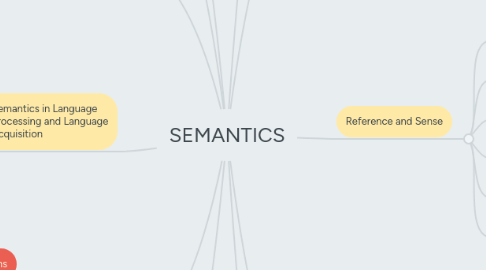SEMANTICS
por elinda herawati


1. Semantic (Lexical) Fields
1.1. Collocations
1.2. Idioms
2. Semantics and the Dictionary
2.1. • Semantic universals
2.2. • Dictionary and its lexical entries
2.3. • How meanings are arranged in a lexical entry
3. Sentence relations
3.1. • Situation types
3.2. • Modality
3.3. • Evidentiality
4. Semantics in Language processing and Language Acquisition
4.1. • How linguists study the way that people process presuppositions and implicatures
4.2. • The time-course of presupposition and implicature processing
4.3. • How linguists study the semantics of child language
4.4. • Development of presuppositions and implicatures in children
5. Pronouns
5.1. • The semantics of deictic pronouns
5.2. • Anaphora
5.3. • Cataphora
5.4. • The semantics of pronominal gender features
6. Semantics and Syntax; Semantics and Pragmatics (Utterance Meaning)
6.1. • Speech acts
6.2. • Perlocutions and illocutions
6.3. • Felicity conditions
6.4. • Propositions and illocutions
6.5. • Conversational implicatures
7. Introduction to Semantics as a Scientific Discipline
7.1. • Basic ideas in Semantics
7.1.1. Sentences
7.1.2. Utterances
7.1.3. Propositions
7.2. • Meaning, sign and symbol
8. Types of Meaning
8.1. • What is meaning?
8.2. • Some Types of Meaning
8.2.1. Literal
8.2.2. Figurative
8.2.2.1. Metaphor
8.2.2.2. Metonymy
8.2.2.3. Synecdoche
8.2.3. Denotative
8.2.4. Connotative
8.3. • Leech’ Classification of Meaning
8.4. • Sentence/Word Meaning & Speaker Meaning
9. Reference and Sense
9.1. • Naming
9.2. • Concepts,
9.3. • Meaning sense and reference
9.4. • Kinds of referents
9.5. • Equative sentence,
9.6. • Linguistic relativity
10. Lexical Semantics
10.1. Fields and Collocation
10.1.1. • Word forms
10.1.1.1. Lexeme
10.1.1.2. Lexicon
10.1.2. • Semantic field theory vs truth conditional semantics
10.1.3. • Paraphrases
10.1.4. • Entailments
10.1.5. • Contradictions
10.1.6. • Lexical relations
10.1.6.1. • Homonymy
10.1.6.2. • Polysemy
10.1.6.3. • Synonymy
10.1.6.4. • Hyponymy
11. Lexical Semantics
11.1. Sense and Relation
11.1.1. • What is an antonym?
11.1.2. • Kinds of antonymy
11.1.3. • Antonymous relations
11.1.3.1. Binary/non binary antonyms
11.1.4. • Symmetry and reciprocity
